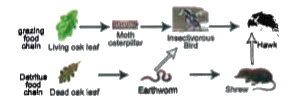What is food chain? Explain briefly grazing food chain and detritus food chain.
Food Chain. It is a sequence of interlinked organisms in an ecosystem through which fix and energy flows with each member becoming the food of the successive member in the sequence. Detritus food chain (DEC) begins with detritus or dead organic matter. Devi yore% and decomposers feed over it. Therefore, food energy present in detritus passes into them. Detrivores and decomposers are consumed by smaller carnivores which in rum become food for larger carnivores and so on. A common detritus food chain with earthworm as detrivores is

Grazing food chain (GFC) is the most common food chain. It is also called predator food chain as predation occurs at every step.
Composition of Predator or Grazing Food Chain. The food chain consists of producers, consumers and decomposers. The latter art often omitted since they operate at all the levels of the food chain. Consumers arc often of 3.5 types-first order (primary), second order (secondary), third order (ternary), fourth order (quartern,) consumers.
1. Producer. They constitute the first trophic level or base of a food chain. Producers are autotrophic organisms which alone are able to manufacture organic food from inorganic mw materials in the process of photosynthesis. The energy for this process is obtained from solar radiations or sunlight. The latter is changed into chemical energy by chlorophyll. The chemical energy is used in combining raw materials into organic food. Oxygen is evolved in the process,
6CO2+6H2O underset(Enzymes) overset("Light chlorophyll")to C6H12O6+6O2
Organic food synthesized by producers consists of all essential ingredients like carbohydrates, fats, proteins, vitamins, etc. It contains energy. Part of the food manufactured by the producers is used up by then in providing energy for various body activities and in overcotting entropy. The rest is employed in their body building. Part or whole of the latter enters the food chain as food consumers. Producers are also known as transducers because they are able to change radiant or light energy into chemical form.
2. Primary Consumers or Herbivores. They are animals which feed on plants or plant products, e.g., grasshoppers and several other insects, rabbi, hare, field mouse, deer, antelope. elephant, zoo (Paramecium, Daphnia, some larvae), tadpoles, some fishes. A pan of plant food eaten by herbivores become constituent of their body while a major part is consumed by them in production of energy for various body activities. Herbivores arc also called key industry animals (Elton, 1927) because they convert plant matter into animal matter.
3. Secondary Consumers or Primary Carnivores. They ingest or prey upon herbivorous - animals, e.g., frog, predator insects, several birds, fishes, wild cat, fox, jackal (also scavenger), etc. A part of flesh or food obtained from herbivore is used in body building by prim, carnivore while the rest is consumed in providing energy for various life process.
4. Tertiary Consumers or Secondary Carnivores. They are larger carnivores which prey upon primary carnivores, e.g., wolf (feeds on fox), snake (prey upon frog).
5. Top Carnivores. They arc the I. order consumers or carnivores which are not preyed upon by other animals because of their size, agility and ferociousness, e.g., shark, crocodile, eagle . peacock, tiger, lion.
A food chain may terminate at the level of herbivore ( e,g vegetation →elephant) primary carnivore (e.g vegetation → squirrel → bear) secondary carnivore (vegetation → squirrel → wild cat → tiger) tertiary carnivore, etc.
Examples of some common food chains are given below
(i) FOod chains on land
1. Grass → Grass Hopper → Frog→ Snake → Peacock/falcon
2. Vegetation → Rabbit → Fox → WOlf → Tiger
3. Vegetation → Insect → Predator insect → Small crustaceans → Predator Insects → King/fisher/ Stork
Related Playlists
- BOOK - BETTER CHOICE PUBLICATIONCHAPTER - ECOSYSTEMEXERCISE - MOST EXPECTED QUESTIONS30videos
ECOSYSTEM
- BOOK - BETTER CHOICE PUBLICATIONCHAPTER - ECOSYSTEMEXERCISE - SHORT ANSWER TYPE QUESTIONS II24videos
ECOSYSTEM
- BOOK - BETTER CHOICE PUBLICATIONCHAPTER - BIOTECHNOLOGY AND ITS APPLICATIONSEXERCISE - LONG ANSWER TYPE QUESTIONS18videos
BIOTECHNOLOGY AND ITS APPLICATIONS
- BOOK - BETTER CHOICE PUBLICATIONCHAPTER - ENVIRONMENTAL ISSUES EXERCISE - LONG ANSWER43videos
ENVIRONMENTAL ISSUES
Similar Questions
Define grazing food chain
View SolutionWhat is the difference between a grazing food chain and a detritus food chain?
View SolutionState differences between grazing food chain and detritus food chain.
View SolutionDistinguish between
(a) Grazing food chain and detritus food chain
(b) Production and decompositionView SolutionWhich one is detritus food chain ?
View SolutionGiven figure represents food chains of a deciduous woodland linked together to form a food web.

Which of the following constitute first trophic level of the grazing food chain and the detritus food chain respectively ?View SolutionDistinguish between the following : (a) Grazing food chain and detritus food chain. (b) Abiotic and biotic components. (c) Net primary productivity and gross primary productivity.
View SolutionA grazing food chain always starts with :
View SolutionA detritus food chain in comparison to grazing food chain is
View SolutionWrite an example of a detritus food chain.
View Solution

